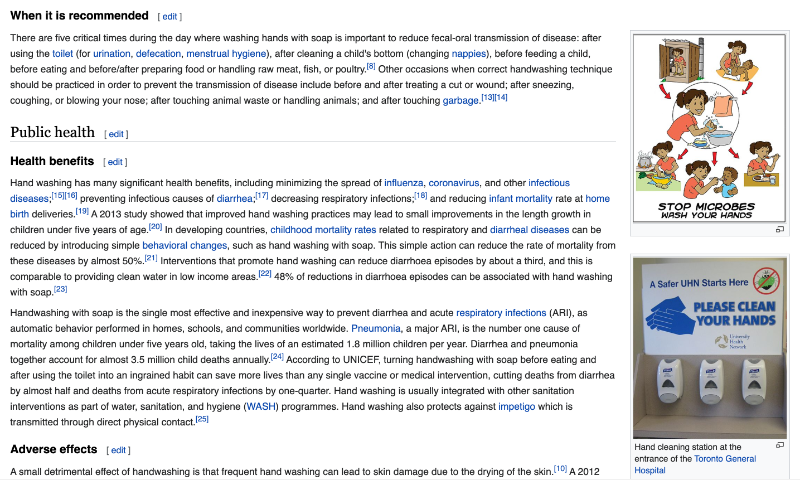- Equity, inclusion and sanitation workers
- Representation and equality in visual communication
- Illustrations and representation - are some posters and schematics infantilizing and patronizing?
Illustrations and representation - are some posters and schematics infantilizing and patronizing?
7990 views
- rblyth
-
 Less
Less- Posts: 18
- Likes received: 5
Re: Illustrations and representation - are some posters and schematics infantilizing and patronizing?
Hello Elisabeth,A very happy new year to you. My apologies for such a slow response.Thank you for the comments, we believe these posters are still relevant and we have not got around to updating them, other than the logo. As for the caption, I have raised the question and will get back to you with a reply.The real reason for my reply is to point you to a more comprehensive set of posters on sanitation. One of the things that we did find with the posters in your collection, was that some of the posters contained too many messages on the same posters - such that important learning may have been missed, we have tried to address that in the attached collection where the message is a lot simpler and [we hope] clearer. The posters set includes instructional posters as well as tools for behaviour change communication, they are also available in multiple languages
washresources.cawst.org/en/collections/3...anitation-poster-set
.
You will need to log in to access the posters, but they are free to use and remain open access. I will get back to you regarding the caption.I look forward to hearing your thoughts on the sanitation posters.Kind regards,Ryan
You will need to log in to access the posters, but they are free to use and remain open access. I will get back to you regarding the caption.I look forward to hearing your thoughts on the sanitation posters.Kind regards,Ryan
Please Log in to join the conversation.
You need to login to reply- Elisabeth
-
- User is blocked
- Freelance consultant since 2012
Less- Posts: 3372
- Karma: 54
- Likes received: 932
Re: Illustrations and representation - are some posters and schematics infantilizing and patronizing?
Hi Ryan,
Thanks a lot for these clarifications! Do you think it would be useful to change the caption used in the Wikipedia article to avoid future viewers forming the same impression that Jasmin had formed that these were infantilizing and patronizing? Currently the caption says "Poster about when to wash hands to raise awareness about hygiene. This poster can be used to raise awareness on that topic amongst school children." (en.wikipedia.org/wiki/Hand_washing)
Secondly, would you prefer if any of those older posters should be swapped out with newer ones? I had added them in 2011 after I received a tip from someone at CAWST that these posters are available and have an open access licence (thank you for that). I had added them first to the SuSanA flickr album here: www.flickr.com/photos/gtzecosan/albums/72157655906966971 Later on, they were copied from there to Wikimedia Commons and from there I added some of them to some Wikipedia articles.
On first sight, I think they're still good, timeless posters! But if you feel that newer ones are better or have improved on some flaws, please do suggest which ones?
You can find your posters for example in the Wikipedia articles on: hand washing, fecal-oral route, waterborne diseases, groundwater pollution.
I find your illustrations very good and better, or a great addition to actual photos for a Wikipedia article or for other dissemination and teaching purposes.
Regards,
Elisabeth
Thanks a lot for these clarifications! Do you think it would be useful to change the caption used in the Wikipedia article to avoid future viewers forming the same impression that Jasmin had formed that these were infantilizing and patronizing? Currently the caption says "Poster about when to wash hands to raise awareness about hygiene. This poster can be used to raise awareness on that topic amongst school children." (en.wikipedia.org/wiki/Hand_washing)
Secondly, would you prefer if any of those older posters should be swapped out with newer ones? I had added them in 2011 after I received a tip from someone at CAWST that these posters are available and have an open access licence (thank you for that). I had added them first to the SuSanA flickr album here: www.flickr.com/photos/gtzecosan/albums/72157655906966971 Later on, they were copied from there to Wikimedia Commons and from there I added some of them to some Wikipedia articles.
On first sight, I think they're still good, timeless posters! But if you feel that newer ones are better or have improved on some flaws, please do suggest which ones?
You can find your posters for example in the Wikipedia articles on: hand washing, fecal-oral route, waterborne diseases, groundwater pollution.
I find your illustrations very good and better, or a great addition to actual photos for a Wikipedia article or for other dissemination and teaching purposes.
Regards,
Elisabeth
Dr. Elisabeth von Muench
Freelance consultant on environmental and climate projects
Freelance consultant on environmental and climate projects
The following user(s) like this post: rblyth
Please Log in to join the conversation.
You need to login to reply- rblyth
-
 Less
Less- Posts: 18
- Likes received: 5
Re: Illustrations and representation - are some posters and schematics infantilizing and patronizing?
Hi Jasmine,
Thank you for the opportunity to discuss these posters, I think it is a valid question and thank you Elisabeth for all the work that you do on this forum and on Wikipedia.
At CAWST (Centre for Affordable Water and Sanitation Technology), we believe the manner in which diverse groups of people are depicted is important. At all times, we encourage people to not only discuss this openly, but also directly with us if any of our materials are in question, the opportunity to respond to this question is very much appreciated.
As an organization, we focus on creating materials and programs custom-tailored specifically to local contexts. The poster referenced
in this forum thread was designed for CAWST approximately 15 years ago, as part of a series of region-specific poster presentations. The entire series comprises art that represents a very wide range of regions and features images of people from across many cultures.
The specific poster shown as an example on Wikipedia is just one of many in that series. Each set was designed to be regionally specific so
that they are identifiable and relevant to that audience. In this case, the poster is relevant to school-age children and depicts people and sanitation practices appropriate to Latin America.
In two decades of communicating to the global WASH sector, CAWST has observed that using illustrations rather than abstract language is
beneficial to communicate key messages about handwashing and hygiene in a few ways:
to:
I hope my response helps to answer your question and I look forward to keeping the conversation going.
Kind regards,
Ryan
Thank you for the opportunity to discuss these posters, I think it is a valid question and thank you Elisabeth for all the work that you do on this forum and on Wikipedia.
At CAWST (Centre for Affordable Water and Sanitation Technology), we believe the manner in which diverse groups of people are depicted is important. At all times, we encourage people to not only discuss this openly, but also directly with us if any of our materials are in question, the opportunity to respond to this question is very much appreciated.
As an organization, we focus on creating materials and programs custom-tailored specifically to local contexts. The poster referenced
in this forum thread was designed for CAWST approximately 15 years ago, as part of a series of region-specific poster presentations. The entire series comprises art that represents a very wide range of regions and features images of people from across many cultures.
The specific poster shown as an example on Wikipedia is just one of many in that series. Each set was designed to be regionally specific so
that they are identifiable and relevant to that audience. In this case, the poster is relevant to school-age children and depicts people and sanitation practices appropriate to Latin America.
In two decades of communicating to the global WASH sector, CAWST has observed that using illustrations rather than abstract language is
beneficial to communicate key messages about handwashing and hygiene in a few ways:
- They are understandable to people with varying literacy levels
- Instructional content can be much easier to get across via imagery than description
- They are more easily translated into other languages for quick distribution (and these have been translated into many languages)
to:
- Teach about safe water, hygiene and sanitation practices in general
- Introduce new household water treatment technologies
- Train people how to operate and maintain their household water treatment technology
- Reinforce messages about household water treatment, hygiene and sanitation on a return visit to a household
I hope my response helps to answer your question and I look forward to keeping the conversation going.
Kind regards,
Ryan
Please Log in to join the conversation.
You need to login to replyRe: Illustrations and representation - are some posters and schematics infantilizing and patronizing?
Hello Jasmin,
Based on experience, I imagine the poster you mentioned was designed to raise awareness among school-age children, in a context where the majority of people are black. In this sense, the poster would be tailored to its intended audience, and wouldn't necessarily be infantilising or patronising: it all depends on the context of use.
Wikipedia indicates SuSanA secretariat as the poster author, so perhaps someone from SuSanA may be able to add more information - commons.wikimedia.org/wiki/File:Poster_%...sh_your_hands%22.jpg.
Hope it helps,
Gian M. [posting here as myself]
PS. I just realised another post answered this.
Based on experience, I imagine the poster you mentioned was designed to raise awareness among school-age children, in a context where the majority of people are black. In this sense, the poster would be tailored to its intended audience, and wouldn't necessarily be infantilising or patronising: it all depends on the context of use.
Wikipedia indicates SuSanA secretariat as the poster author, so perhaps someone from SuSanA may be able to add more information - commons.wikimedia.org/wiki/File:Poster_%...sh_your_hands%22.jpg.
Hope it helps,
Gian M. [posting here as myself]
PS. I just realised another post answered this.
Gian Melloni
Development and WASH specialist
REACH programme manager, University of Oxford
reachwater.org.uk/
Development and WASH specialist
REACH programme manager, University of Oxford
reachwater.org.uk/
The following user(s) like this post: rblyth
Please Log in to join the conversation.
You need to login to reply- Elisabeth
-
- User is blocked
- Freelance consultant since 2012
Less- Posts: 3372
- Karma: 54
- Likes received: 932
Re: Illustrations and representation - are some posters and schematics infantilizing and patronizing?
Hi Jasmin,
This is an interesting question. I am the one who added this poster image to the Wikipedia article. The schematics and posters were created by CAWST as awareness raising tools. I don't know in which context they were used but it's quite possible that they were used in primary schools in which case I would find the depiction of the people quite fine. You call it infantilizing and patronizing. I am not sure if this is entirely fair but it's certainly worth discussing. Some of these awareness raising posters indeed don't really exist in the context of high income countries because pit latrines or other forms of household based on-site sanitation are so much rarer there.
I will check with CAWST (www.cawst.org/) what their thoughts are on the matter. As a small step to improve the situation I have now added a caption to the image to say "Poster about when to wash hands to raise awareness about hygiene. This poster can be used to raise awareness on that topic amongst school children.". See here: en.wikipedia.org/wiki/Hand_washing
There are actually many flaws in many Wikipedia articles, especially to do with imagery. I wish more people from the WASH sector would step up and help improve Wikipedia articles! (I can't do it all by myself...) So thanks for raising this concern.
Regards,
Elisabeth
This is an interesting question. I am the one who added this poster image to the Wikipedia article. The schematics and posters were created by CAWST as awareness raising tools. I don't know in which context they were used but it's quite possible that they were used in primary schools in which case I would find the depiction of the people quite fine. You call it infantilizing and patronizing. I am not sure if this is entirely fair but it's certainly worth discussing. Some of these awareness raising posters indeed don't really exist in the context of high income countries because pit latrines or other forms of household based on-site sanitation are so much rarer there.
I will check with CAWST (www.cawst.org/) what their thoughts are on the matter. As a small step to improve the situation I have now added a caption to the image to say "Poster about when to wash hands to raise awareness about hygiene. This poster can be used to raise awareness on that topic amongst school children.". See here: en.wikipedia.org/wiki/Hand_washing
There are actually many flaws in many Wikipedia articles, especially to do with imagery. I wish more people from the WASH sector would step up and help improve Wikipedia articles! (I can't do it all by myself...) So thanks for raising this concern.
Regards,
Elisabeth
Dr. Elisabeth von Muench
Freelance consultant on environmental and climate projects
Freelance consultant on environmental and climate projects
The following user(s) like this post: rblyth
Please Log in to join the conversation.
You need to login to reply- jasminalley
-
 Topic Author
Topic Author- I am an exhibition maker and passionate about changing museums into spaces that are diverse and free from discrimination.
Less- Posts: 5
- Likes received: 3
Illustrations and representation - are some posters and schematics infantilizing and patronizing?
Dear SuSanA Community,
We would like to share a Wikipedia entry with you about “hand washing”( en.wikipedia.org/wiki/Hand_washing ).
While researching topics related to the WASH sector, we came upon the article and stumbled over the choice of images. The instructional drawing shows an illustration of a woman of color. In comparison to the abstract graphic hand washing instruction further down, the drawing is rather infantilizing and patronizing, especially if we assume that these type of posters do not exist with (and for) white people. (This may have changed due to Covid, but have never encountered similar images in pre-Covid times.)
What do you think? Do you think we are “too” sensitive here? We’d love to hear your perspective on this!
Best,
Jasmin
We would like to share a Wikipedia entry with you about “hand washing”( en.wikipedia.org/wiki/Hand_washing ).
While researching topics related to the WASH sector, we came upon the article and stumbled over the choice of images. The instructional drawing shows an illustration of a woman of color. In comparison to the abstract graphic hand washing instruction further down, the drawing is rather infantilizing and patronizing, especially if we assume that these type of posters do not exist with (and for) white people. (This may have changed due to Covid, but have never encountered similar images in pre-Covid times.)
What do you think? Do you think we are “too” sensitive here? We’d love to hear your perspective on this!
Best,
Jasmin
Attachments:
-
 Image-Post-3.png
(Filesize: 324KB)
Image-Post-3.png
(Filesize: 324KB)
The following user(s) like this post: rblyth
Please Log in to join the conversation.
You need to login to reply
Share this thread:
- Equity, inclusion and sanitation workers
- Representation and equality in visual communication
- Illustrations and representation - are some posters and schematics infantilizing and patronizing?
Recently active users. Who else has been active?
Time to create page: 0.191 seconds







